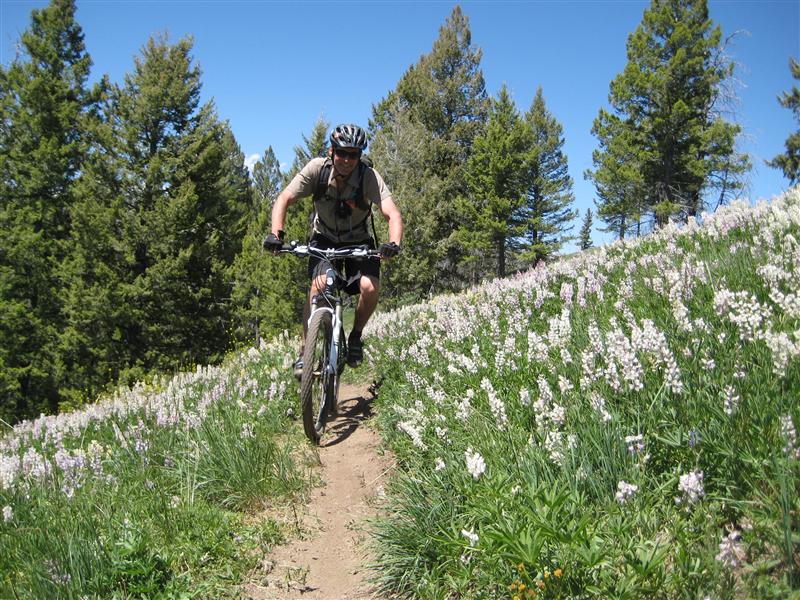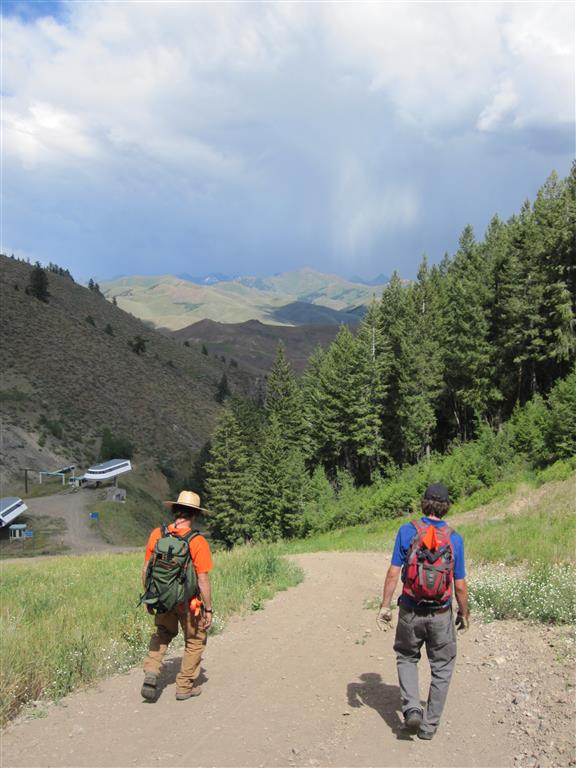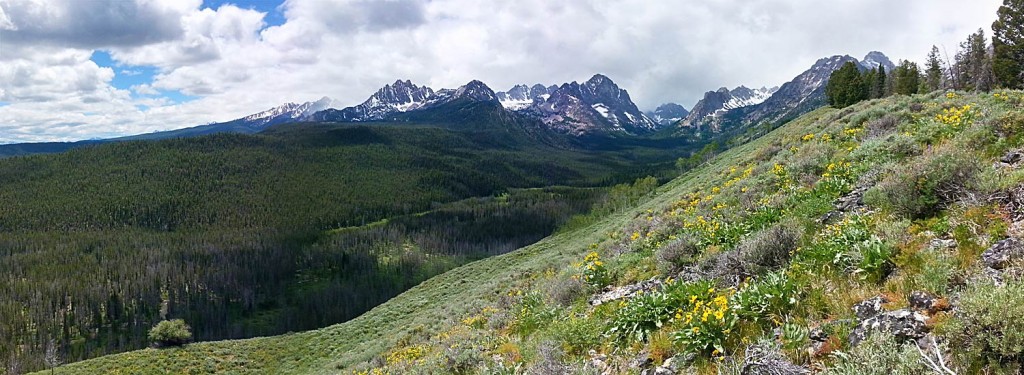We live in Idaho’s Wood River Valley for many reasons, but high on many people’s list of reason’s for living here is a love for the mountains and the chance to get out on a trail to enjoy them.

The pandemic has brought many changes, but we still have the trails, and thankfully they’re open to our “almost-normal” use. But things are busy out there. The parking lots at Greenhorn, Adams Gulch, and at other area trailheads are often packed, and the use of our “trade-routes” seem to be at an all-time high. Some problems have come with that busyness.
Many who are now coming here to hike, backpack or ride are new to the ways of the trails. Back in the day, we all had to work to learn the ropes, and we had time to gradually introduce new people to the rules of etiquette that many of us now take for granted.

People did a good job of helping newcomers learn the ins and outs of sports like mountain biking, motorcycle riding and horseback riding. We helped fellow backpackers, hikers, runners and dog walkers understand the need to care for the lands we visit, and to respect the other people we meet along the way.
That ethic, of patiently steering our fellow trail users to do the right thing, needs to carry on today. While we are doing so, let’s strive to let our local character shine. Keep your engagements with others friendly and informative. We can’t force people to be our-version of good, but we can try to let them know that we need to work together. If you feel the need to educate another trail user, do it politely.

Below you will find a list of trail etiquette guidelines that I hope will be used widely as an aid in helping inform the public about our responsibilities on the trails and at trailheads. I would like to thank Medicine Wheel Trail Advocates, a trail group in the Pike’s Peak region of Colorado, for generously allowing me to borrow heavily from their excellent etiquette recommendations.
I implore everyone to work to get the word out to treat the trails and other trail users right, and for everyone to be mindful of, and heed, these simple, but important rules of the trail.
Wood River Valley Trail Etiquette Guidelines – Summer 2020
Having access to the trails heals our minds, bodies and souls. With the current virus situation our trails are being taxed more than ever. The additional use, including from many new users who aren’t familiar with some aspects of trail etiquette, can lead to misunderstandings and trail damage.
We all need to do our part to help reduce trail conflicts and care for the resources we enjoy. Here are some guidelines that will help improve everyone’s trail experiences.
Mountain Bikers: Everyday mountain bike etiquette
- Try not to startle other users. Ride with a bell and/or announce your presence in a friendly way.
- When passing hikers, cyclists must yield. What does yield mean? As a cyclist it is ultimately your responsibility to avoid startling or crashing into someone (or entering their safe-space). This means riding in control at all times, being able to slow down and stop if necessary, and to negotiate a safe pass. This may include dismounting, and even backing up. Often, it’s easier for a hiker to move to the side of the trail to let a bicyclist pass, and most hikers will do this if there is a safe place and the rider communicates with them. Pass slowly and safely, thank them, and continue on your way.
- If you are riding downhill and encounter someone riding uphill – you must yield to them. Slow down, stop, and get as far off the trail as necessary to allow an unimpeded passing. Often a downhill rider can stop and lean well-out and away from the trail; to allow the other rider to pass safely.
- If you encounter an equestrian, moving either toward, or away from you, slow down, stop as necessary and engage in a conversation about the best way to pass.
- If there are others in your group, let the person you’re passing know how many of your group are behind you and still to come.
Additional guidelines for mountain bikers during this time of social distancing
- Ride solo or in very small groups – not with the squad. Large groups of heavy-breathers are not appropriate at this time.
- Tame your ride down to reduce risk; for you, and everyone. Don’t wind up in the ER because you wanted to hit that big jump you’ve been eyeing.
- Training for a race? Consider putting in more time than normal on the road to reduce trail congestion.
Hikers/Trail Runners
- Maintain situational awareness – you are sharing the trail. Expect and watch for others.
- Cyclists are required to slow down and yield to those on foot. Often it is easier for hikers to step off a narrow trail, to allow cyclists to pass. Hikers are not required to yield to cyclists, but if you are able to, please cooperate with cyclists to let them pass safely.
- When encountering others near turns, avoid standing on the outside edge of turns. When riding up or down, most cyclists prefer to travel through the outside areas of turns, where it is often safer and easier for a cyclist to get through. When encountering cyclists, please stand on the inside of turns, or away from the turn altogether.
- If hiking in groups, try to keep them small, and spread out so that other users can pass safely.
Equestrians
- Choose trails that are appropriate for your skill level, and for the comfort level of your horse.
- If your horse needs practice on more technical trail moves, or being around other users, consider seeking out instruction or practice-time at one of the equine training facilities in the valley.
- Work with other users to share the trail.
Motorized
- Ride on trails and roads designated as open to your mode of travel and that are appropriate to your skill level and experience. Utilize area motor-vehicle-use-maps and other appropriate maps and tools when planning your route. Resources for helping you determine what roads and trails are open to your chosen mode of travel can be found near the bottom of this document.
- When meeting others on the trail, slow down and stop to facilitate a safe passage. Some local riders stop, shut off their machines, take off their helmets and say hi. Every encounter may not require that level of patience and courtesy, but take it easy and help others enjoy their outing.
ALL USERS, during this time of social distancing
- The health and safety of our community is the most important thing right now, and we all have a role to play in lightening the load on our emergency response and medical systems. If we work together, we can weather the storm and help keep the trails open for responsible, safe use.
- With limited exercise options, our trails are getting more use than ever. Help reduce crowds by riding or walking to trails whenever possible. If you do drive, do it safely and slow down through neighborhoods.
- Don’t crowd trailheads and don’t congregate in groups on trails. Groups present the biggest risk to spreading the virus.
- Wear a mask, especially at trailheads. If you find you can’t wear it all the time, pull it up when passing others out on the trails.
- Don’t spread COVID. Stay up-to-date on public health recommendations:
Idaho Department of Health and Welfare
Blaine County, Idaho official website
- Remember that everyone is here to enjoy the trails, just like you. Smile, cooperate, help others. If you feel the need to educate another trail user about etiquette, do it politely.
ALL USERS
- Don’t travel on muddy trails. If you come upon a puddle, on a trail that is otherwise dry, go right through it, not around it. Don’t contribute to trail widening. Keep the singletrack single.
- Don’t block the trail. If you need to stop, for any reason, move to the side of the trail.
- If you will be out with your dog or other pet, learn and follow the regulations for the area you will be in. At some area trailheads pets must be leashed, and it is a good idea to leash your pet in other congested areas.
- If using headphones or earbuds, keep the volume low enough to hear and engage with other users.
Additional Resources:
BCRD Summer TraiLink (local trail info website): summertrailink.bcrd.org
Sawtooth National Forest Motor Vehicle Use Maps: https://www.fs.usda.gov/detail/sawtooth/maps-pubs/?cid=stelprdb5421960
Idaho Department of Parks and Recreation brochure about off-highway-vehicle laws including Idaho rules and guidelines for motor vehicle use, safety, and trip planning: IDPR OHV Brochure
Trail maps with use designations for the state of Idaho – Idaho Department of Parks and Recreation mapping program: Idaho Trail Mapping Program

